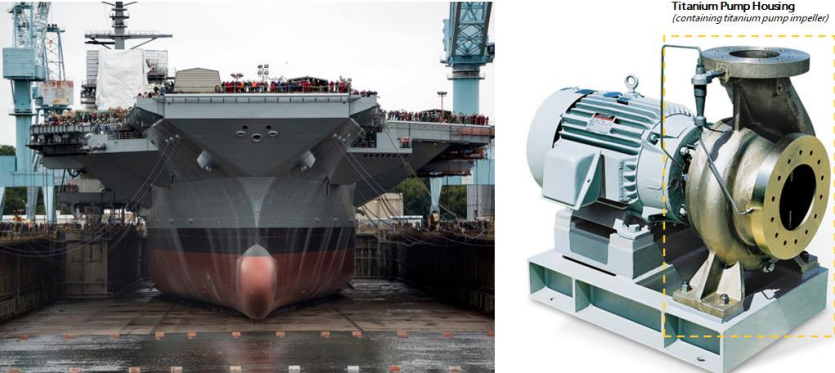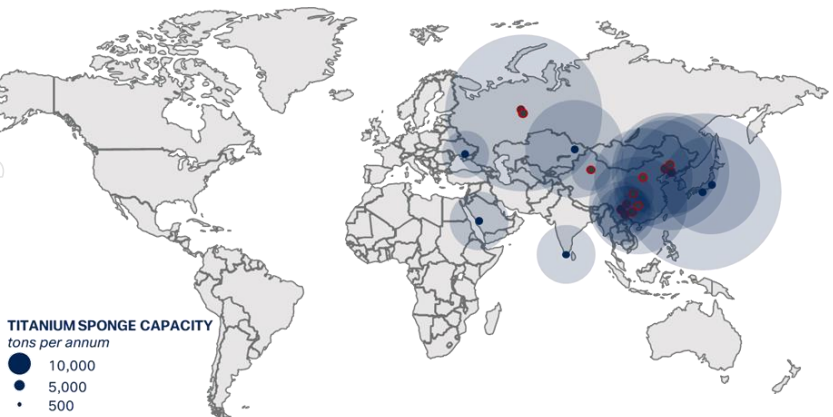IperionX, a titanium alloy producer, and Carver Pump a certified ISO 9001/2015 pump manufacturer, have partnered forces to offer additively manufactured titanium parts for the US Navy. Carver will design these parts, assist IperionX in prototyping and supervise the qualification process.
The US Navy’s Naval Sea Systems Command has developed additive manufacturing methods for over 500 components used in US ships and submarines. The Governor of Virginia and the US Navy are intensifying their efforts to expand AM, having recently inaugurated the ‘Additive Manufacturing Center of Excellence’ in Danville, VA, which is only twenty-five miles from IperionX’s new Titanium Demonstration Facility.
“In just four months, we’ve seen dynamic progress from IperionX,” said Glenn Youngkin, Governor of Virginia. “As they continue to develop synergies with Carver Pump and the US Navy using 100% recycled titanium scrap as feedstock which will soon be produced in Halifax County, we look forward to seeing IperionX’s continued growth and success.”
“We see this partnership as the first step in a larger relationship focused on both Navy surface ships as well as new parts for other marine applications,” said Andrew Carver, CEO at Carver Pump.

IperionX: Why choose IperionX to produce titanium parts
IperionX highlights that titanium casting is a very expensive manufacturing technique and can present significant issues due to two primary reasons titanium’s high melting point (1,670oC) and high reactivity with oxygen. To avoid unwanted reactivity, titanium must first be vacuum melted before being poured into ceramic molds.
The United States does not have the ability to produce large titanium castings for high-performance centrifugal pump designs. This results in long lead times for parts that are imported from overseas. These specialized titanium pump elements can be additively manufactured using IperionX’s lower-carbon, US-based titanium powders. As a result, the US Navy will be able reduce lead times for crucial components, increase equipment availability, and sustainably return to shore a vital US supply chain of titanium metal.
IperionX’s titanium production pilot facility in Utah is actively developing high-quality titanium metal powders from 100% reprocessed titanium feedstocks for client qualification. This titanium manufacturing facility is reported to have achieved 100% processing yields from low-grade scrap, without the need for combining it with high quality primary titanium metal.
“Our partnership with Carver is another important milestone for the rapid commercialization of IperionX’s breakthrough titanium technologies,” said Anastasios (Taso) Arima, IperionX CEO.
Furthermore, titanium centrifugal pumps are chosen by the US Navy for their “exceptional” corrosion resistance, efficiency, and durability in demanding naval applications. These pumps are used for fire suppression, electronics cooling and main propulsion seawater.
Carver has provided high-performance centrifugal pumps for the US Navy since World War II. Carver pumps are used by all Navy shipbuilding programs such as Aegis Destroyers (Ford Carriers), Zumwalt Destroyers; America Big Deck Amphibious Asault Ships; Virginia Submarines; Littoral Combat Ships; and San Antonio Amphibious Transportation Docks.
“We are delighted to be working with IperionX to help introduce domestically sourced, 100% recycled titanium into the US Navy’s supply chain. When coupled with the benefits of Additive Manufacturing, the partnership provides a significant potential to benefit Navy operations through the rapid production of complex, operation-critical titanium parts, providing a potential reduction in lead times and increasing equipment availability,” added Carver.
“These patented technologies can efficiently recycle domestic titanium scrap metal at a lower cost than existing processes, and this high-quality titanium metal can be used for a range of manufacturing technologies, including Additive Manufacturing. We look forward to working closely with Carver to rapidly prototype and deploy titanium components for a wide range of centrifugal pump applications in US Navy platforms,” added Arima.
IperionX is reshoring US-made titanium parts
IperionX is actively involved with the US Navy to detail the firm’s plans to re-shore the US titanium distribution network in a sustainable manner, with the goal of reducing critical titanium part cost, carbon emission, and lead times.
Senior leadership from NAVSEA, along with the Office of the Chief Engineer for Ship Design, Integration, and Naval Engineering, the Shipbuilding Industrial Base Task Force, and the Program Executive Office – Strategic Submarines, participated in these discussions. IperionX discussed the possibility of processing titanium scrap inventory to be used throughout Defense Industrial Base, in collaboration with the US Defense Logistics Agency Strategic Materials agency.
IperionX also works with the Naval Air Systems Command on flight-critical and additively manufactured titanium parts. These discussions follow IperionX’s victory in the US Air Force Research Laboratory’s titanium recycling Grand Challenge, and they highlight the importance of re-shoring a US titanium supply chain for allied and domestic defense industries.
NAVSEA announced its goal to create technical guidelines for additively manufactured parts to enhance operational readiness. These guidelines are intended to produce long-lead parts and obsolete parts. They also aim to enhance defense capabilities by creating novel component designs that wouldn’t otherwise be possible.

Metal AM powers the defense sector
Recently, Australian large-format 3D printer manufacturer AML3D, announced the sale of a large-scale, industrial ARCEMY ‘X-Edition 6700’ Wire Arc Additive Manufacturing (WAAM) metal 3D printing system for assisting the US Navy’s advancing integration of WAAM technology. WAAM, according to the firm, is critical for rapidly boosting parts supply to the US Navy’s submarine industrial base. BlueForge Alliance, a US Department of Defense intermediary placed the ARCEMY Order with the purpose of accelerating enhanced manufacturing methods within the US defense industrial base.
The US Navy also installed the first Phillips Additive Hybrid 3D printing solution for metal onboard. It was powered by Meltio and Haas metal 3D printer developers. The Phillips Additive Hybrid powered by Haas combined Meltio’s laser metal deposition technology with the Haas CNC vertical machining centers that control the mill on the USS Bataan ship. Rear Adm. Brendan McLane, the Commander, of Naval Surface Force Atlantic, said, “The introduction of additive manufacturing (AM) into naval operations supports readiness and self-sufficiency.”
What is the Future of 3D printing What will the next ten-years hold?
What engineering challenges What challenges will be faced in the future by the additive manufacturing industry?
To stay up to date with the latest 3D printing news, don’t forget to subscribe to the 3D Printing Industry Newsletter Follow us on TwitterLike our page or send us an email Facebook.
While you’re here, why not subscribe to our Youtube channel? Featuring discussion, debriefs, video shorts, and webinar replays.
Are you interested in a job within the additive manufacturing sector? Visit 3D printing jobs Here are some examples of the roles available in this industry.
Feature image shows USS Gerald R Ford in dry dock in Newport News, VA & Carver Pump M-Series ASTM F998 close coupled centrifugal pump. Image via IperionX.




